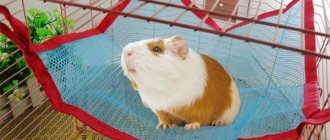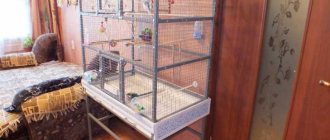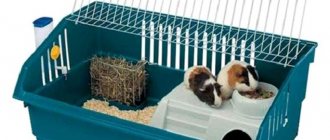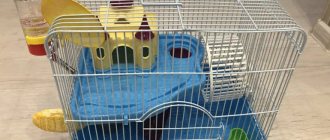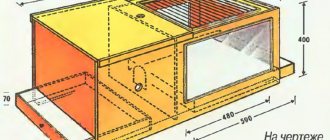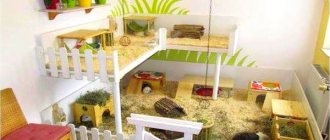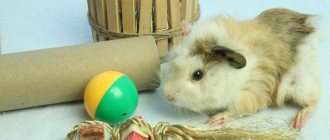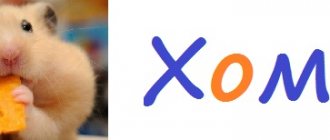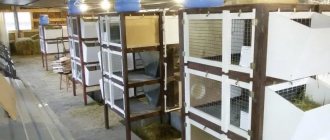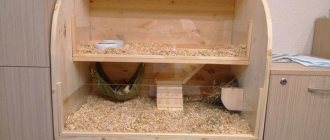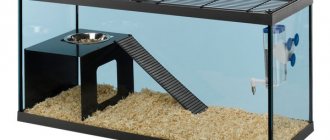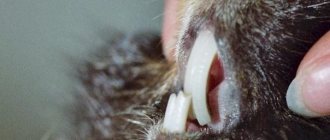Contrary to prevailing stereotypes, guinea pigs are very different from other rodents (for example, hamsters) both in character and lifestyle. Therefore, housing for these animals must be arranged in accordance with their needs.
Let's find out which cages are suitable for guinea pigs and how to properly equip them, and step-by-step instructions for creating a house for a rodent with your own hands will help you with this.
Material of manufacture
The catalog of cages for animals presents different options, but many are not even worth considering. A bad material for keeping a guinea pig is wood. Although such cells look beautiful, they absorb dirt and odors. The rodent happily sharpens its teeth on wooden beams, destroying the cage.
Often in a pet store they try to force a terrarium or an aquarium on the buyer. The main argument is that dirt and sawdust will not fly into the room. But in such containers there is no ventilation. The animal will breathe fumes from excrement. In addition, the guinea pig’s brain is designed in such a way that the animal does not see what is happening behind the glass, and in such a house it will feel lonely.
Popular sections:
Aquariums Sale of kittens and puppies Terrariums Products for cats Products for dogs
The optimal composition of the cage is a plastic tray and metal rods. Such houses are durable, resistant to moisture, easy to wash and do not collapse under the influence of disinfectants.
Aviaries and summer paddocks
Most often, a guinea pig enclosure is an apartment. It is around the apartment that the animal runs around, studying the surrounding objects, climbing into a variety of places and causing a lot of trouble for the owner. Some animals get stuck in cracks between furniture, manage to get tangled in wires, or get underfoot. The animals are very active and it can be difficult to keep track of their movements.
To protect the animal, you can equip it with a special enclosure or pen in the room, or even better, on the balcony.
If the balcony is insulated, then the animal can walk there in winter. It’s good to install several labyrinths and holes in the pen, hang hammocks, lay out toys and don’t forget to hang some mangers for hay or grass. The running animal will want to eat. If the breeder has a summer house and spends the whole summer there, then you can set up a summer pen for the guinea pig in the open air. This will be very useful for the animal, but you should follow some rules. First and most important, the enclosure must have reliable shelter from any bad weather and be inaccessible to any other animals and birds. There must be several houses for pigs in the pen. If they are installed at different heights, it is necessary to take care of the safety and convenience of ladders for animals.
A summer pen can be made from mesh, but it is better to use the shape of a wooden box with one or two sides made of mesh with a mesh of no more than three centimeters. This design protects from bad weather, predators, and drafts. You cannot install the pen directly on the ground - it is better to use a special stand or legs. This will avoid dampness, cold and infection by many parasites. The size of the summer pen is most often several times larger than the size of the cage. For one animal, a pen with dimensions of 150 by 200 cm is suitable. A large area will allow the pig to move a lot and not feel lonely even when the owner is busy with his dacha affairs. The summer paddock should be equipped with several feeders and drinkers, one or two houses, labyrinths and toys.
Design
An important point when choosing a cage for a pet is the correct design. You cannot take a cage for birds, hamsters, ferrets or any other pets. Such structures are dangerous for a guinea pig because they are too high and do not have a clear division into floors, and the pet can get injured in them. Remember other useful tips:
- The safe height for the animal is 10-15 centimeters; objects and accessories cannot be placed above this mark.
- Choose houses of rectangular or square shape (the main thing is large width).
- The removable cage cover makes cleaning easy.
- If you have several pets or plan to breed them, choose cages with dividing panels and ramps.
- If you travel frequently, buy a crate that can be disassembled and assembled so you can take your pet with you.
DIY guinea pig cages
Before starting construction, it is worth considering all the positive and negative aspects of homemade cages, studying the necessary materials and tools for the work, and understanding the manufacturing instructions.
Pros and cons of homemade structures
The undoubted advantage of creating cells with your own hands is complete control over the process. The pet owner decides what the house will be made of, how the work will be done, and what the end result should be.
Thus, the advantages of personal participation in production:
- quality of material - you can choose natural, safest and strongest parts of the future design;
- ideally selected sizes - depending on the number of pets and the availability of free space in the apartment;
- unique appearance and the ability to best arrange the cage.
But there are also disadvantages to homemade cages: if the calculations are incorrect and the basic requirements are not met, the result will be an unsuitable home for your pet, and time and effort will be wasted.
In addition, some types of materials require serious skills in working with them. For example, metal, wood or glass require a special set of tools.
Required materials and tools
Getting ready for work:
- metal grate (distance between bars - no more than 2.5 by 10 cm);
- construction ties or wire;
- grinder or hacksaw;
- polycarbonate sheet or corrugated cardboard;
- pencil;
- roulette
Manufacturing instructions
Let's take a step-by-step look at how to make a cage for a guinea pig with your own hands.
We plan the appearance of the structure: we draw up a drawing of the house with the required dimensions.
Prepare the grate. If the blanks purchased at a hardware store do not fit in size, they are adjusted using a grinder or a hacksaw.
You need to make 4 rectangular grilles of the same width: back and front, as well as two side ones.
The gratings are held together with plastic ties or wire.
Important! All sharp edges are ground down or hidden so that the animal cannot reach them.
We will make the bottom from polycarbonate, where the filler will be located. This container is cut larger than the cage. In the corners of the polycarbonate sheet you need to make small cuts so that the walls seem to be inserted into one another and create small sides.
Important! If corrugated cardboard is chosen for the pallet, it must be covered with tape several times or painted with acrylic to protect it from moisture.
If the cage includes a 2nd floor, you can construct a shelf on it from leftover polycarbonate or equip a mini-house.
You can also create a large cage from several standard cells, between which there will be holes for movement.
Filler
Filling is placed in the pet's cage, otherwise the animal is at risk of fungus, various types of dermatitis, hair loss and other health problems. This is a necessary part also for the following reasons:
- the animal's paws are adapted to soft surfaces;
- the filler plays the role of a toilet;
- the pig needs to dig and dig for something.
Experts recommend different beddings, each of which has its own advantages and disadvantages.
| Type | pros | Minuses |
| Wood sawdust | They absorb moisture well, soft, inexpensive. | Almost do not absorb odors, often cause allergies |
| PVC mat | Pleasant soft surface, with it the food will lie separately from the filler | Not used separately, there must be filler underneath. There is a risk of poisoning from the substances from which the mat is made. |
| Toilet paper | Sold in any store, soft, does not cause allergies | Impractical, instantly saturated with odor and moisture |
| Absorbent diapers | Convenient to use | Dear ones, they get dirty quickly |
| Hay or straw | Natural natural material | Your guinea pig will quickly eat this stuffing. |
| Fleece | In demand among pig breeders in Europe, it is warm, stays dry for a long time, can be washed and used many times | Also not used separately, only complete with filler. |
Whatever you use, keep in mind that the main rule is that the filler should be as natural as possible, without dyes or toxic additives.
Arrangement
Once a pet's cage has been purchased, it should be well equipped. First of all, you need bedding, and it is advisable to choose the filler from straw and paper (these are excellent thermal insulators that will keep the animals warm). It is not recommended to lay the filler from pine and cedar sawdust, as they contain a lot of phenol, which is dangerous for rodents. Since pigs like to dig deep tunnels and bury themselves, the layer of filler should be at least 7 cm.
Rodents are clean and love exclusively dry, clean litter, so the bedding must be periodically replaced with a new one, removing wet areas.
In addition, the pet’s housing must be equipped with the following elements.
- Drinking bowl. It is advisable to give preference to containers made of glass and ceramics; fresh water is constantly poured into them and installed in such a way that the liquid does not spill or fall on the filler. You can also use a plastic or glass bottle as a drinking bowl; it is hung at a certain height so that the fluffy can reach it freely. Such bottles must be thoroughly washed with a brush once a week when cleaning the cage.
- Feeder. It should be shallow and wide, as pets like to eat with their paws on its edges. No need to buy big bowls. As for the material of manufacture, the best option is containers made of ceramics; plastic is not recommended. Ceramic bowls last much longer and pets do not chew through them.
Article on the topic: How to trim a guinea pig's claws at home: step-by-step instructions
The feeder should be placed away from the “toilet” and washed when it gets dirty, as animal excrement and litter can get into it.
are also considered equally important for guinea pigs , which are most often used in cardboard boxes or wooden cubes. Since pets love to chew on everything, a good solution would be to place mineral pebbles in the house. You cannot buy toys coated with paint in specialized stores.
If you wish, you can make toys for your pet yourself from rolls of toilet paper, cardboard boxes and paper bags. It is worth paying attention to the fact that only large toys are suitable for rodents, since they can swallow small ones, which will cause suffocation.
One of the main components of the cage should be a hammock. To prevent the animal from injuring itself, it is important to monitor how it uses the hammock. Additionally, the structure can be equipped with a secluded corner by making a small canopy or tunnel. Animals love to hide and are often embarrassed when secluded in their hiding place. Elements for the corner can either be purchased ready-made in a store or made with your own hands.
Labyrinths are also suitable for games. A tunnel made independently from a can of round bread or chips is in no way inferior to store-bought versions. To do this, first remove the sticker and all metal parts from the can. Such labyrinths can keep an animal interested for a long time, which will prevent its obesity in the future and have a positive impact on its health.
Food
A healthy diet will prolong the life and improve the health of your pet. Remember the correct diet of the animal:
- hay – 60%;
- vegetable and fruit components, greens – 30%;
- dry food – 10%.
The main product on the animal’s menu is hay. It forms healthy digestion for your pet and supplies it with all the necessary substances and vitamins. The most useful is considered to be hay made from cereals and beans, clover, alfalfa, and nettle. Hay is purchased or prepared independently.
Guinea pigs are primarily herbivores, so the menu should include seasonal fruits and vegetables. Pieces that are not eaten before the next feeding are thrown away. Your pet's daily diet should include at least 5 types of vegetables and herbs. The animal is offered sprouted grains and seeds, branches of trees and shrubs along with leaves and flowers (acacia, birch, maple, poplar). Remember that many plants, such as lilacs, and most indoor flowers are poisonous to guinea pigs.
Toys
Interesting toys will delight your guinea pig. But owners must remember what items are prohibited from being placed in a rodent’s cage:
- running wheels;
- walking balls;
- rings and bells on ropes.
Guinea pigs are slow and inflexible animals; they have weak spinal muscles. The following items can cause serious injury. Tunnels are great for stimulating physical activity. A good choice would be tennis or ping-pong balls, cubes, and any high-quality toys for leisure and grinding down the rodent's teeth.
How to properly arrange your home
Having decided on the choice of house, you can begin to arrange it. It is necessary to place everything necessary to provide the basic needs of the guinea pig.
The room must have:
- drinking bowl;
- feeder;
- tray with filler;
- bedding made of tarpaulin or sawdust.
To make your pet's life interesting and varied, you can place a variety of accessories in its home. For movement, wooden shelves connected by a ramp can be attached to the walls.
We recommend learning how and what to play with guinea pigs.
You can also place a wooden mini-shelter in a secluded corner. The animal will rest and sleep in it. All sorts of toys will not be superfluous. But at the same time they must be made of organic materials. Plastic accessories for rodents are not allowed.
